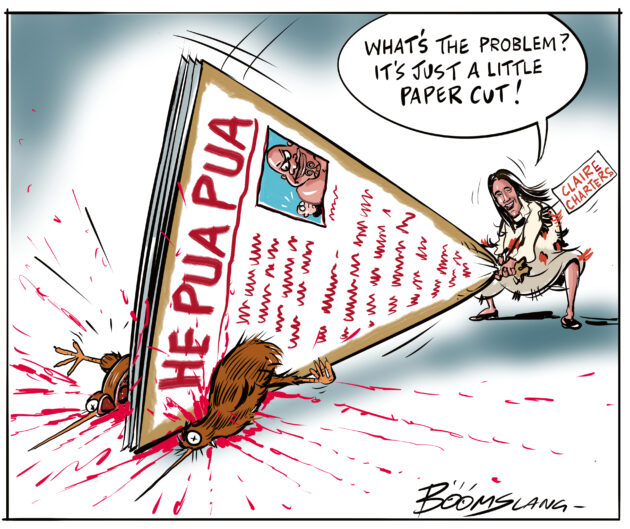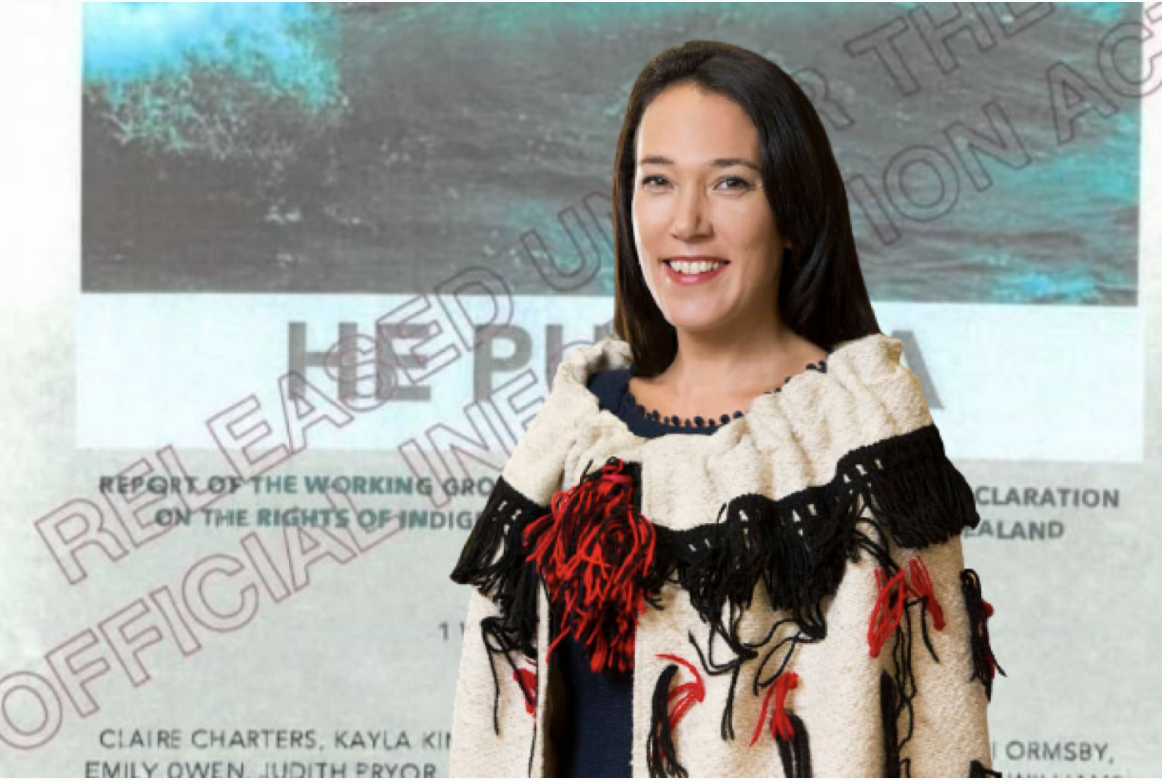Bruce Moon
hobsonspledge.nz
Bruce Moon is a former member of the staff of the University of Canterbury. He was a member of the Professorial Board with the same status (reader) as an associate professor.
“No historian, however detached, works without an ideological framework.”
Charles Freeman, “Egypt. Greece and Rome”, 1996, p.241
So here we are with yet another Associate Professor, Claire Charters, expounding grossly false ideas about the Treaty of Waitangi[i],[ii]. After all ‘associate professor’ is quite a high rank in university circles and so we should expect that what any of them writes is accurate and of good quality. But no! Ms Charters’ article displays all the treaty-twisting so typically peddled by such people[iii] to which she adds the extraordinary claim that the treaty, “our rock, [is] New Zealand’s constitutional foundation”. That this semi-formal agreement – not even a treaty in the real sense – which had fulfilled any role it was ever meant for by May 1840 should be so described demonstrates all too vividly the hysteria which surrounds it today.

She compounds the nonsense which she delivers by claiming that the relevance of this “rock” in the “Covid-19 era” fits “[r]ight in the centre, together with He Whakaputanga o te Rangatiratanga o Nu Tireni and the UN Declaration on the Rights of Indigenous Peoples.” The most impressive sounding “He Whakaputanga etc.”, may I remind readers, was Busby’s paper tiger, the so-called “Declaration of Independence” of the non-existent “Confederation of Chiefs”, which he persuaded some chiefs to sign in a “contrived ceremony” at Waitangi in October 1835 in exchange for a “cauldron of porridge” but which “had no constitutional status” and was “silly and unauthorised”.[iv] This has not stopped manipulative officialdom placing it in a display cabinet along with the original treaty document and act granting the vote to women at a cost of around $7 million to New Zealand taxpayers.
Again, while in a manipulative move by former Prime Minister, John Key, Peter Sharples did go to the United Nations and sign the Declaration on the Rights of Indigenous Peoples, it is contempt for genuinely indigenous people to describe the Maoris as such. After all, not only was their arrival a mere few hundred years before Tasman’s visit but we even know the names of the vessels which they came in!
In a further flight of her fevered imagination, Ms Charters makes the nonsense claim that “te Tiriti sets out who has authority to regulate New Zealand … the form of laws, rules and power … to address and respond to Covid-19. Te Tiriti tells us that the New Zealand state government has some authority (kawanatanga), and that Maori have some authority (rangatiratanga), and that state law and Maori law regulate together.”
May I remind readers again that by the treaty, the chiefs agreed to cede sovereignty, “kawanatanga”, completely and forever to the Queen, this exercised today by Parliament, that all Maoris – their many slaves included – were granted the same[v] rights as the people of England and the property rights, “rangatiratanga” of all the people of New Zealand[vi] were guaranteed. Anything else[vii], including a spurious “partnership” is yet again the product of our hordes of treaty-twisters![viii]
Ms Charters then proceeds to tell us in the light of her false claims with respect to the foregoing, what should be done – “It would be good to see more effort by state government to work in partnership with Maori government to jointly devise and implement strategies, under law, to address Covid-19” with more on “indigenous rights”. Despite the underhand work of Key and Sharples, this latter is entirely irrelevant in New Zealand, but Charters slips it in with:
“If authority, and power, is not exercised in accordance with te Tiriti – or human rights, or Indigenous peoples’ rights – it is illegal and illegitimate.”
Compounding this barrage of false claims, she concocts the nonsense claim that “te Tiriti imposes restrictions on state government, te Karauna.” – and she is a senior member of a Law School!
And then: “What we know for sure is that Maori do not enjoy equity with non-Maori in today’s Aotearoa.” Does she not know that by the current count, since 1974 there have been at least ninety (90) items of New Zealand legislation in which Maori interests are specifically addressed – an astonishing state for an associate professor of law!?[ix]
Ms Charters continues by referring to “seemingly ‘neutral’ Covid-19 strategies on Maori”.
Neutral are they with the immediate but ill-founded allocation under the Covid-19 emergency of $56 million specifically to Maori interests, about as grossly racist as one can imagine!?[x]
But she does not stop even there, continuing to echo the further treaty-twisting by Hugh Kawharu,[xi] amongst others, that “te Tiriti protects Maori rights to taonga Maori, including our culture” into which her imagination allows her to weave national management of the Covid-19 emergency!
Despite the dramatic claim with which she concludes, the Treaty of Waitangi is not a beacon which “must continue to be the lighthouse on the shore, guiding our way.” It did glow brightly for a few brief months as the Maori chiefs sought the benefits of becoming British subjects but now, despite the strident claims of latter-day revisionists, it is nothing but “a handful of grey ashes, long, long ago at rest”.[xii]
Furthermore, despite her very obviously predominant European ancestry, Claire Charters indulges in the pretence of declaring only some Te Arawa descent. It must be a matter of considerable concern to responsible New Zealanders that she “chaired the government-appointed working group to advise it on a plan to realise the UN Declaration on the Rights of Indigenous Peoples [whose report] is being considered by Cabinet.”
It must surely be another matter of very considerable concern that national news media do not exercise some informed discrimination and decline to publish such infantile nonsense as the tales of Associate Professor Claire Charters of the University of Auckland Law School.
Sources:
[i] Newsroom, Ideasroom, 19th April 2020
[ii] Others include Sandy Morrison, Leonie Pihama and Tom Roa, all of Waikato, with Maria Bargh and senior lecturer Carwyn Jones of Victoria.
[iii] B. Moon, “New Zealand, the Fair Colony”, ISBN 973-0-473-52123-3, 2020, pp 61ff
[iv] Quotations from M. King, “The Penguin History of New Zealand”, ISBN 978-0-14-301867-1, 2003, pp 154-5
[v] My emphasis
[vi] My emphasis again
[vii] Apart from a provision for the sale of Maori land which soon became a dead letter
[viii] The Governor-General and the Prime Minister amongst them
[ix] 1Law4All, “Are we being Conned by the Treaty Industry?”, www.1Law4All.kiwi.nz, 2020
[x] At the time of writing, there are proportionally less cases of Covid-19 infection in people of Maori descent than in the rest of the population.
[xi] See for instance I Wishart, “The Great Divide”, ISBN 978-0-9876573-6-7, HATM Publishing Ltd, 2012, p. 275
[xii] W. (Johnson) Cory, “Heraclitus”, 759, “The Oxford Book of English Verse”, 1912
Please share this article so that others can discover The BFD.

